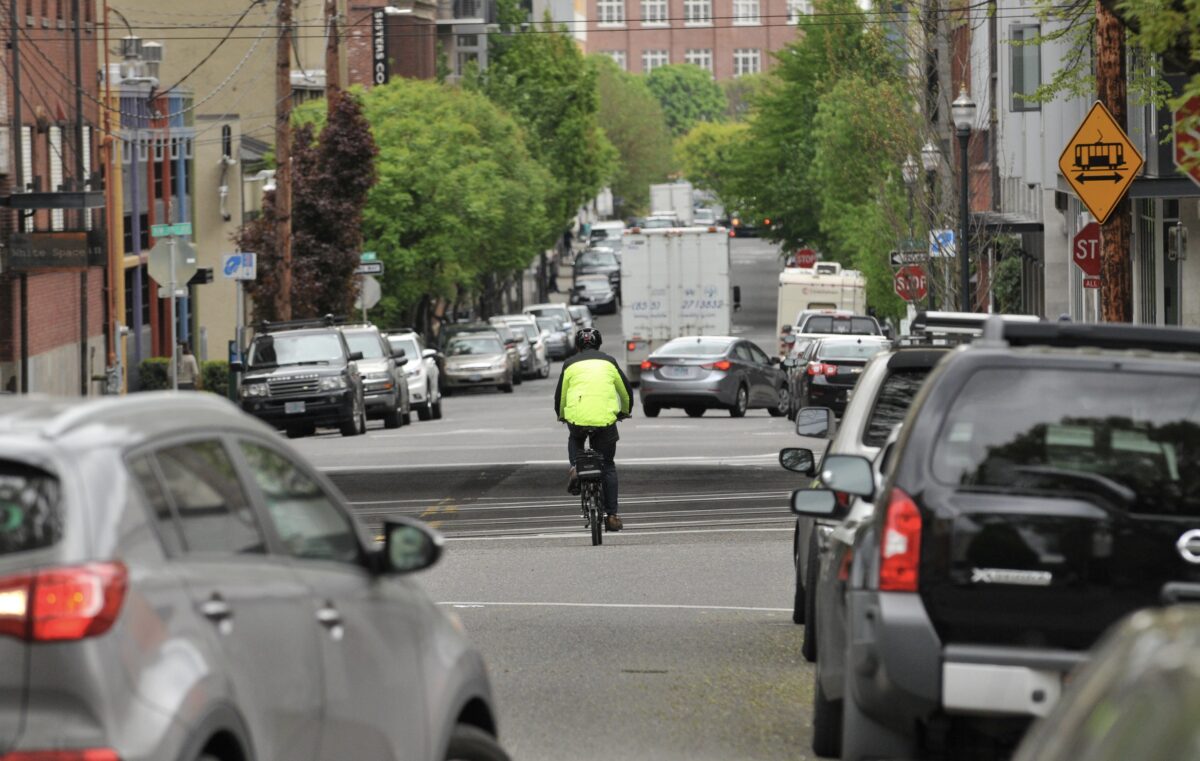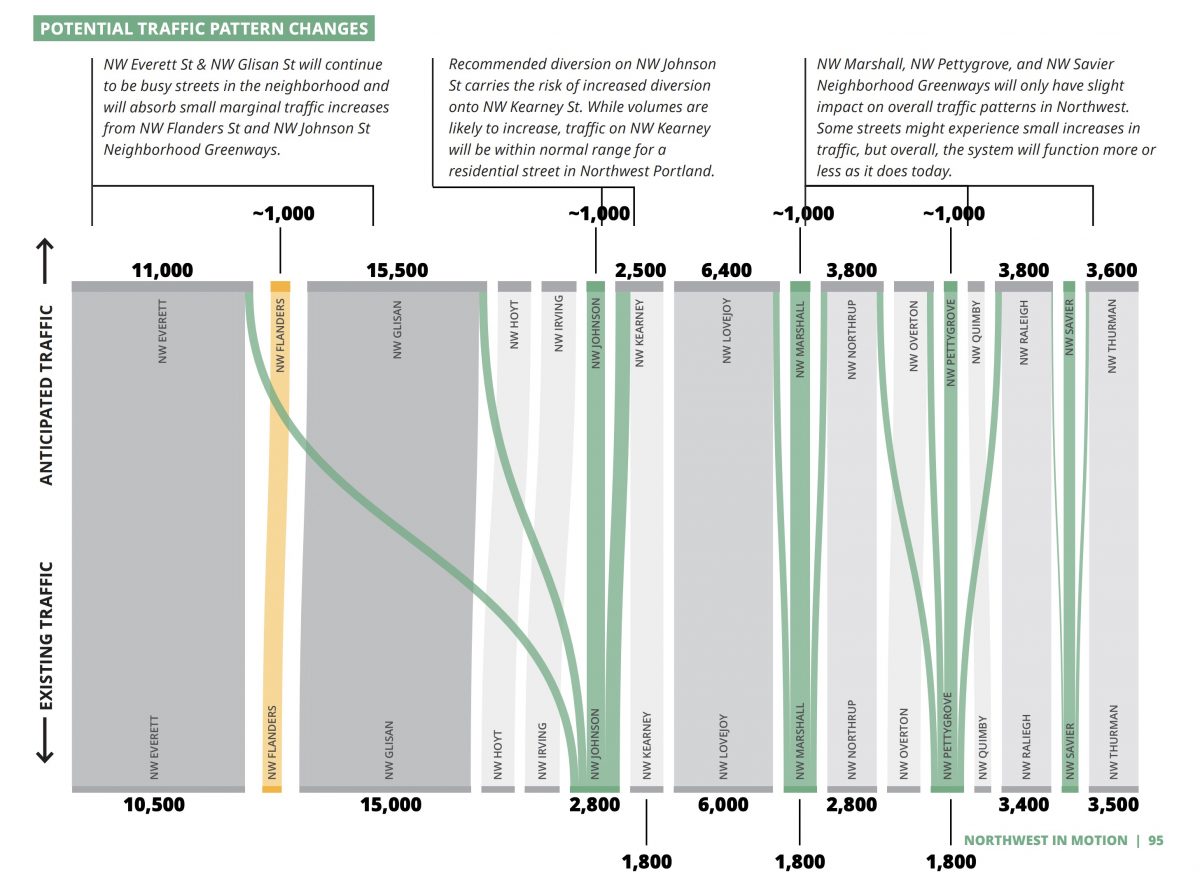
(Photo © J. Maus/BikePortland)
A plan the Portland Bureau of Transportation hopes will double bicycle use in northwest is out in draft form and you have from until December 20th to share feedback.
PBOT has released an online open house and draft of NW In Motion (NWIM), which includes a prioritized list of projects and programs aimed at boosting carfree travel in a 490 acre swath of inner northwest bordered by Burnside, I-405, Vaughn and the West Hills.
More than just a plan, PBOT says they’ve got funding identified for all but one of their 10, “Tier 1” projects and they plan to start building the first three early next year. The Tier 1 projects consist of five neighborhood greenways and five “corridor improvements”. PBOT estimates that nine of the projects would cost $5 million to build (a repave of NW 23rd would cost $8 -10 million).
Advertisement

Northwest’s relatively dense land-use and connected street grid should make it one of the best places for people who want to drive less. But northwest is far from reaching its biking, walking, and transit potential because of outdated infrastructure; it lacks major dedicated bikeways, its neighborhood greenways are virtually nonexistent (all of them fail to meet city guidelines for auto user speed and volumes), crossing its busy streets is risky, transit service is hard to access and buses are often delayed during peak hours.
Traffic data shows that 44% of northwest Portlanders drive alone to work. That’s higher than it should be given that 37% of all trips in the plan area are less than three miles long and PBOT’s drive alone mode split goal is just 30%.




To encourage less driving, PBOT and a volunteer advisory committee have met seven times since May 2018. Their resulting list of projects and policies focuses on changes that can be implemented within five years.
Here’s the list of Tier 1 projects:
Neighborhood Greenways
● NW Johnson St – 9th to 25th: Retrofit of existing greenway that includes alternating one-ways between 12th and 18th and median islands for safer crossings of 16th and 14th.
● NW Marshall St – 9th to 20th: Retrofit of existing greenway that includes full diverter at 15th.
● NW Pettygrove / NW Overton St – 9th to Cornell: New greenway that includes removal of rails on 15th and one-way only section (eastbound) between 9th and 10th.
● NW Savier St – 14th to 29th: New greenway that includes interim, two-way carfree street between 19th and 20th and improved bike cut-through at 29th and Wilson.
● NW 24th Ave – Flanders to Vaughn: Retrofit of existing greenway that includes new carfree block between Westover and Flanders.
Corridor Improvements
● NW 25th Ave / Westover Rd: Calm traffic along NW 25th Ave and NW Westover Rd by adding traffic slowing devices and enhanced pedestrian/bicycle crossings.
● NW 23rd Ave: Improve the safety and asset condition of the northern section of NW 23rd Ave by reconstructing the roadway, rebuilding an aging signal, improving pedestrian crossings, and enhancing transit stops.
● NW 18th/19th Ave: Provide improved crossings, transit islands, and reduced bike/bus conflicts on NW 18th/19th to serve the Line 24 Extension.
● NW Everett / Glisan St: Improve safety along the NW Everett/Glisan couplet by adding crossing improvements and reducing traffic speeds. Improve bus stop accessibility and reduce transit delay on the Line 77 from NW District to the Pearl District and Old Town / Chinatown.
● NW Vaughn St: Improve safety along NW Vaughn St and NW Wardway by adding improved crossings, bikeway enhancements, and transit priority treatments. bike boxes at25th , safer crossings at 24th.
In addition to infrastructure, PBOT wants to implement a broad set of new policies and programs which could be have more impact than the projects.
The program recommendations include: improved street lighting, “daylighting” of intersections, a prohibition on right-turns-on-red, signals with leading pedestrian intervals, lower speed limits, and more.
As per their previously adopted vision clearance policy PBOT will recommend a 20-foot parking setback at intersections of all new greenways, busy commercial and transit streets, and streets near schools. Going further, PBOT says they’ll consider retroactive daylighting of problematic intersections and study the impacts of parking setbacks every intersection in the district.
Advertisement
One of the most exciting policy recommendations in the plan is a district-wide 20 mph speed limit. Since less than a dozen streets currently have speed limits above 20 mph, lobbying from advocates and committee members helped convince PBOT that a continuous 20 mph zone is feasible.
Interestingly, while the intent of the plan is to discourage driving, PBOT was careful to not create too much inconvenience for people who use cars — at least in the short-term.
The plan took steps to “preserve neighborhood circulation”, a PBOT euphemism for maintaining current levels of driving capacity. PBOT was also careful to “reduce the impacts to parking supply.” The plan would install auto traffic diverters only on the periphery of the quadrant (to reduce cut-through traffic from out of the area) and it proposes to remove 56 parking spaces while adding 16 new ones.
Looking to balance calls for more diversion with concerns about driving convenience, PBOT plans to take a phased approach. Phase one will “reinforce existing edges” of the plan area with diversion aimed at changing driving patterns of people who cut-through neighborhood when nearby freeways back up. If this initial effort fails to reduce the amount of drivers on neighborhood greenways, PBOT will consider additional diverters, but only after “a clear period of traffic monitoring and community engagement.”
In a section of the plan that describes benefits and impacts, PBOT said their approach to parking came from a desire to, “Balance the need for better walking, biking, and transit routes with the reality that some businesses and individuals will still rely on driving for at least some of their trips.”
Advertisement

Instead of striping dedicated bike lanes, PBOT says they took a shared-lane, neighborhood greenway approach because it would have less impact on parking supply. Given that nearly all of the streets in the plan area are relatively narrow (36-feet wide), PBOT would have to remove all parking to create a bike lane while maintaining two lanes for auto users. PBOT explained their approach in the plan:
An analysis of the impact to on-street parking was run, in which the proposed neighborhood greenways were replaced with bike lanes, to compare it with the parking impact of the recommended neighborhood greenway approach. The results were a reduction of 1,231 parking spaces in the plan area, which would have significant negative impact on residents and businesses by dramatically reducing the available parking supply.
While PBOT is planning for a future that is less reliant on on-street parking than today, this change must be gradual to allow residents and businesses to adapt to these changes. Based on this analysis, the Northwest in Motion Plan recommends the neighborhood greenway approach because the impact of proposed traffic diversion to be much less than the impact of removing 1,231 parking spaces.
Not only did PBOT try to maintain the existing number of parking spaces, they also looked for “opportunities to add parking where it is currently prohibited, as a way to mitigate for the parking that is proposed for removal.”
Even with this light-handed approach to auto use PBOT says once fully implemented the NW In Motion plan will have a “transformational effect,” on northwest Portland, “allowing people of all ages and abilities access to safe and comfortable routes to get around the neighborhood.” Once the recommended projects are built, PBOT expects northwest could bump up its current bike commute mode split from 7% to 14%. If that happens, their models say peak-hour driving trips could fall by 1,200 or about 12,000 fewer cars on the road every day.
When the final plan is adopted sometime in February or March, PBOT would begin construction of updates on Johnson, Marshall and NW 18/19th right away.
Check out the online open house or email NWinMotion@portlandoregon.gov to share feedback.
— Jonathan Maus: (503) 706-8804, @jonathan_maus on Twitter and jonathan@bikeportland.org
— Get our headlines delivered to your inbox.
— Support this independent community media outlet with a one-time contribution or monthly subscription.





